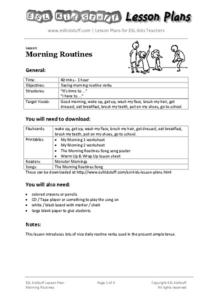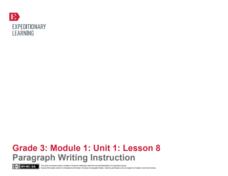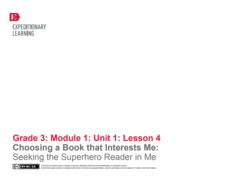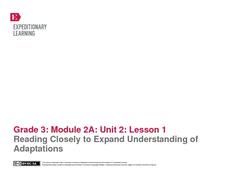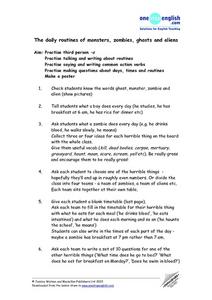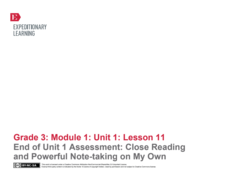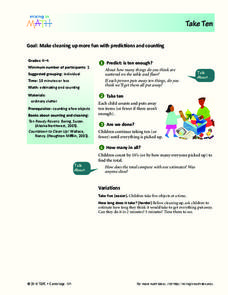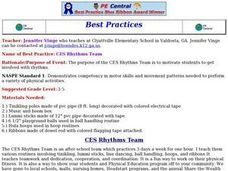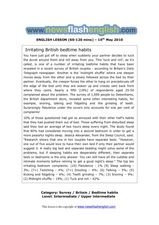ESL Kid Stuff
Daily Routines & Times of the Day
What time do you eat breakfast? Or go to school? Language learners practice crafting and answering questions about their daily routines.
ESL Kid Stuff
Morning Routines
Morning routines are the subject of this series of activities designed for language learners. Kids practice crafting questions and responses using the provided morning routine targeted vocabulary words.
Curated OER
"Here We Go" Parachute Routine
Rather than just shouting out commands on what to do with a parachute, turn some music on and make it a dance routine. This seems like a pretty cool way to engage young learners. Make a dome, hop, make waves, walk, twist, and shake that...
Curated OER
Fluency Instructional Routine: Read Regular Words
How many words can you read in one minute? Practice reading fluency, speed, and accuracy with this scaffolded lesson plan. This offers a full script if you need it, however it can also be utilized as an outline. Demonstrate the activity...
Curated OER
Time & Itineraries Two
Students explore time management by participating in clock reading activities. In this itinerary instructional activity, students define a list of time telling vocabulary terms and practice reading analog clocks with a partner. Students...
Curated OER
Beat the Clock
Tired of wasting time trying to get your class to split up into groups? Engage in an activity to help your charges manage time. Learners reflect on a time they were left out or rejected, and then practice forming groups of three within...
Curated OER
Rules, Routines and Protocols of P.E.
Divided into groups of threes or fours, class members develop skits that demonstrate their knowledge of classroom rules, routines, and protocols.
Media Literacy
Once Upon a Time
Robert Munsch's The Paperbag Princess and Jon Scieszkafrom's The True Story of the Three Little Pigs launch a discussion of the role of stereotypes in stories and movies.
Curated OER
Tom's Daily Routines
After reading a short paragraph about Tom’s daily routines, individuals record their answers to questions based on the paragraph and locate these things in a word search puzzle. Class members then illustrate and write about six of these...
Curated OER
Routines
Students talk about their routine. They learn and practice the simple present, then read an article about an atypical routine. Finally, they write about routines
Curated OER
Jingle Bells Streamer Routine
Students perform movements with streamers as part of a P.E. activity. They dance to the song Jingle Bells, following explicit directions. They practice a dance routine, and can create their own dance.
EngageNY
Paragraph Writing Instruction
Writing a paragraph from details found directly in a text is the central focus of this thorough and explicit lesson plan. Using the stories Nasreen's Secret School and Rain School, third graders are lead step-by-step...
EngageNY
Choosing a Book That Interests Me: Seeking the Superhero Reader in Me
Selecting a "power book" and engaging in a structured class discussion are the learning targets for this fourth lesson in a larger unit. It is designed as a beginning of the year unit for establishing norms and routines in the classroom....
EngageNY
Continued Close Reading of Nasreen's Secret School: Discussions of Questions and Evidence
Third graders answer text-dependent questions of the story Nasreen's Secret School both independently and then collaboratively through using the carousel of questions strategy. This plan is the seventh instructional activity in a...
EngageNY
Reading Closely to Expand Understanding of Adaptations
Third graders work to determine the main idea, recall key details, and answer questions using an informational text on the topic of animal adaptations. Using the non-fiction text "Staying Alive: Animal Adaptations" (provided) the teacher...
Curated OER
The Daily Routines of Monsters, Zombies, Ghosts and Aliens
Students practice writing and speaking about routines and using action verbs. Students create a poster based on their writing about monsters and zombies.
Curated OER
It Takes Two
Third graders examine various exercises in order to distinguish between exercises designed to increase muscular strength and those designed to improve muscular endurance. Groups create a presentation for their "clients" to explain the...
EngageNY
End of Unit 1 Assessment: Close Reading and Powerful Note-Taking on My Own
As the final lesson plan in a larger beginning-of-the-year unit to establish routines and teach close reading skills, this plan is designed as an assessment piece. Using the story, The Librarian of Basra, learners independently...
Curated OER
Tell Me; I’ll Listen
Encourage respect, responsibility, and caring within your classroom with a collection of lessons that spark dialogue and self reflection. To address character traits, lessons touch on topics such as staying safe in the...
Mixing in Math
Take Ten: Make Cleaning Up More Fun with Predictions and Counting
Class members predict and count how many items need to be cleaned up in class while skip counting by 10s. They estimate whether having each child clean up 10 items will be enough to get the room ready for the next day. Everyone counts...
Curated OER
CES Rhythms Team
Students get involved with rhythms. They demonstrate routines involving tinikling, lummi sticks, line dancing, ball handling, hoops, and ribbons. They demonstrate competency in motor skills and movement patterns needed to perform a...
Curated OER
Paper Plate Aerobics
Students participate in physical activities with paper plates under their feet. In this paper plate aerobics lesson, students make original routines consisting of a series of moves and play tag,
Curated OER
Careers and Weather
Students appreciate that many jobs are affected by the weather. In this weather and jobs worksheet students complete a worksheet explaining how various workers make changes in their routines due to weather.
Curated OER
Irritating British Bedtime Habits
Students read an article that discusses bedtime habits in Britain. In this lesson, students explore the complaints of people and their night time habits, then complete several activities to expand their thoughts on the article.

